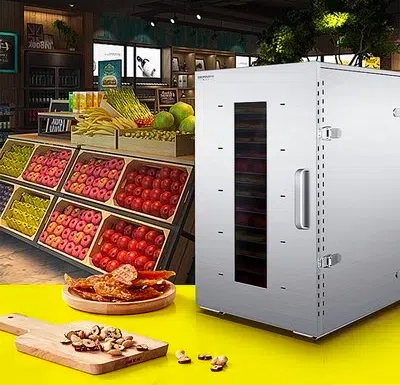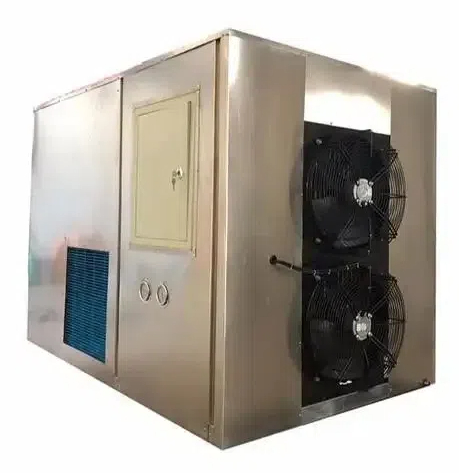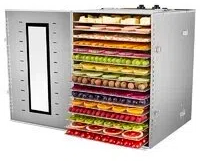
Content Menu
● Introduction
● Understanding Condensing Heat Pump Dryers
>> How It Works
● Benefits of Using a Condensing Heat Pump Dryer
>> 1 Energy Efficiency
>> 2 Gentle Drying
>> 3 Versatile Installation
>> 4 Reduced Environmental Impact
● Applications in Food Drying
>> 1 Preservation of Nutritional Value
>> 2 Consistent Quality
>> 3 Cost-Effectiveness
>> 4 Enhanced Safety
● Comparison with Other Drying Methods
● Innovations in Condensing Heat Pump Technology
>> 1 Smart Technology Integration
>> 2 Enhanced Sensors
>> 3 Improved Design Features
● Conclusion
● FAQs
>> 1: What Is a Condensing Heat Pump Dryer?
>> 2: How Does It Work?
>> 3: What Are Its Benefits?
>> 4: Can It Be Used for Food Drying?
>> 5: Is It Cost-Effective?
Introduction
In the modern world, efficient and effective drying solutions are essential for both households and businesses. Among the various types of dryers available, the condensing heat pump dryer stands out due to its energy efficiency and advanced technology. This article explores the benefits of using a condensing heat pump dryer, particularly in the context of food drying, and how it can revolutionize the way we handle moisture in food processing.

Understanding Condensing Heat Pump Dryers
A condensing heat pump dryer operates by using a closed-loop system that recycles air. Unlike traditional dryers that vent hot air outside, this technology captures moisture from the air and condenses it into water, which is then collected in a tank or drained away. This method not only conserves energy but also reduces drying times significantly.
How It Works
1. Heat Exchange Process: The dryer uses a refrigerant that absorbs heat from the air inside the drum. This heated air is then circulated through the clothes to evaporate moisture.
2. Moisture Removal: The moisture-laden air passes through an evaporator where it cools down, causing the moisture to condense into water.
3. Recycling Air: The now dry air is reheated and sent back into the drum for another cycle, making the process efficient.
Benefits of Using a Condensing Heat Pump Dryer
1 Energy Efficiency
One of the most significant advantages of a condensing heat pump dryer is its energy efficiency. These dryers use significantly less energy compared to traditional dryers, leading to lower electricity bills. For instance, while a conventional dryer may consume around 4 kWh per load, a heat pump dryer typically uses only about 1-2 kWh.
2 Gentle Drying
The lower operating temperatures of condensing heat pump dryers protect delicate fabrics from damage. This is particularly beneficial for food products that require careful handling during drying processes. By avoiding high temperatures, these dryers help maintain the quality and nutritional value of food items.
3 Versatile Installation
Since condensing heat pump dryers do not require external venting, they can be installed in various locations without the need for extensive plumbing or ventilation work. This flexibility makes them ideal for small spaces or areas where traditional vented dryers cannot be used.
4 Reduced Environmental Impact
Using a condensing heat pump dryer contributes to sustainability efforts by minimizing energy consumption and reducing carbon footprints. As more businesses and consumers prioritize eco-friendly practices, these dryers present an excellent solution.

Applications in Food Drying
1 Preservation of Nutritional Value
In food processing, maintaining the nutritional value of dried products is crucial. A condensing heat pump dryer operates at lower temperatures, ensuring that vitamins and minerals are preserved during the drying process. For example, when drying fruits or vegetables, high temperatures can degrade essential nutrients; thus, using a heat pump dryer helps retain their health benefits.
2 Consistent Quality
The ability to control temperature and humidity levels leads to consistent drying results. This consistency is vital for manufacturers who need to ensure that their products meet quality standards. Inconsistent drying can lead to variations in texture and taste, which can affect customer satisfaction.
3 Cost-Effectiveness
Although the initial investment in a condensing heat pump dryer may be higher than traditional models, the long-term savings on energy costs make it a cost-effective choice for food processors. Additionally, reduced spoilage rates due to better drying methods can further enhance profitability.
4 Enhanced Safety
Food safety is paramount in food processing industries. The controlled environment within a condensing heat pump dryer minimizes the risk of contamination during drying processes compared to open-air drying methods or traditional dryers that may expose food to dust and pests.
Comparison with Other Drying Methods
When evaluating different drying methods for food products, it's essential to consider their efficiency and effectiveness:
| Feature | Condensing Heat Pump Dryer | Traditional Dryer | Air Drying |
| Energy Consumption | Low | High | Very Low |
| Operating Temperature | Low (50°C) | High (70-75°C) | Ambient |
| Moisture Management | Excellent | Moderate | Poor |
| Installation Flexibility | High | Low | Very High |
| Environmental Impact | Positive | Negative | Neutral |
This table illustrates how condensing heat pump dryers outperform both traditional dryers and air-drying methods in several key areas.
Innovations in Condensing Heat Pump Technology
As technology advances, so does the efficiency and functionality of condensing heat pump dryers. Recent innovations include:
1 Smart Technology Integration
Many modern condensing heat pump dryers come equipped with smart technology that allows users to monitor and control their appliances remotely via smartphone apps. This feature enables users to adjust settings based on their specific needs and receive alerts when cycles are complete.
2 Enhanced Sensors
Advanced sensors now allow for better moisture detection, ensuring that food items are dried precisely without over-drying or under-drying them. This technology helps maintain product quality while optimizing energy usage.
3 Improved Design Features
New designs focus on user convenience with features such as self-cleaning filters, larger capacity drums for bulk drying, and quieter operation modes—making them suitable for both commercial kitchens and home use.
Conclusion
The condensing heat pump dryer represents a significant advancement in drying technology, particularly for food processing applications. Its energy efficiency, gentle drying capabilities, versatility in installation options, and reduced environmental impact make it an ideal choice for those looking to optimize their drying processes while preserving product quality.As we continue to seek sustainable solutions in food production and processing, investing in technologies like condensing heat pump dryers will be essential for future growth and innovation.

FAQs
1: What Is a Condensing Heat Pump Dryer?
A condensing heat pump dryer is an appliance that uses a closed-loop system to dry clothes or food by recycling air and removing moisture without venting hot air outside.
2: How Does It Work?
It works by circulating heated air through items being dried, collecting moisture as it evaporates, then cooling that air to remove water before reheating it for another cycle.
3: What Are Its Benefits?
Benefits include energy efficiency, gentle drying at lower temperatures, versatile installation options, and reduced environmental impact.
4: Can It Be Used for Food Drying?
Yes, it is ideal for food drying as it preserves nutritional value and ensures consistent quality during the drying process.
5: Is It Cost-Effective?
While initial costs may be higher than traditional dryers, long-term savings on energy bills make it cost-effective over time.












